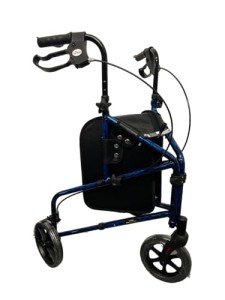lightweight-walker1817
lightweight-walker1817
See What Rollator With Storage Tricks The Celebs Are Making Use Of
Rollator with Storage: A Comprehensive Guide for Independent Mobility
Rollators are mobility aids developed to assist individuals with walking troubles while promoting independence and safety. Unlike conventional walkers, rollators come equipped with wheels for uncomplicated navigation, making them a necessary tool for many elderly and disabled individuals. Among the essential features that improve the performance of rollators is storage. This post checks out rollators with integrated storage options, highlighting their benefits, types, and essential factors to consider when picking the ideal design.
Comprehending Rollators
What is a Rollator?
A rollator is a wheeled walker that provides support for individuals who might deal with balance or endurance. Normally, rollators are created with the following features:
- Wheels: Rollators are geared up with either two or 4 wheels, enabling smooth maneuverability.
- Hand Brakes: Most have hand brakes for added safety, allowing users to control their speed.
- Seat: Many models consist of an integrated seat, providing a resting point when required.
- Storage: Rollators typically feature baskets or bags for bring personal items like water bottles, groceries, or medical products.
Benefits of Using a Rollator with Storage
The addition of storage choices in rollators brings several benefits:
- Convenience: Users can easily transfer personal belongings, lowering the need for additional help.
- Independence: Having access to important products while being mobile empowers individuals to maintain their independence in various environments, such as grocery shops, parks, or homes.
- Safety: By safely storing products, users can more confidently navigate their environments without the danger of dropping important items.
- Convenience: Having a seat for resting permits users to take breaks when required, even more boosting mobility.
Types of Rollators with Storage
Numerous types of rollators come equipped with storage services:
| Rollator Type | Description | Suitable for |
|---|---|---|
| Requirement Rollator | Usually features four wheels and a sturdy frame. Storage options, like a built-in bag or basket, are frequently included. | General use, outdoors |
| Compact Rollator | A smaller version that folds quickly for transport. While these designs frequently have actually restricted storage, lots of still consist of minimal performance. | Travelers and tight spaces |
| Sturdy Rollator | Developed for bigger individuals, these rollators often have better storage capacity. | Bigger users, stability needs |
| Rollator with Seat | Functions a built-in seat for resting. Storage options vary, often including baskets or shopping bags. | Those requiring routine breaks |
| Walker-Carrier Combo | Serve as both a rollator and a lightweight cart, suitable for shopping journeys. | Grocery shopping, outdoor use |
Selecting the Right Rollator with Storage
When selecting a Rollator With Storage (Gitea.Marley.Io), several aspects ought to be thought about to guarantee that it meets specific needs.
Key Features to Assess
- Weight Capacity: Always inspect the weight limit of the rollator to guarantee safety and usability.
- Size and Foldability: Consider how the rollator suits your living area and whether it can be easily stored or transported.
- Storage Capacity: Assess the size and ease of access of storage compartments. Look for alternatives that allow for safe storage without overwhelming the user with complexity.
- Adjustable Handles: Ensure that the handles can be adapted to the suitable height to improve convenience and ergonomics.
- Braking System: A reliable braking system is essential. Make sure the brakes are easy to engage and disengage.
- Wheel Size and Type: Larger wheels can navigate rougher terrain, while smaller sized ones may be more appropriate for flat surface areas.
Extra Considerations
- Accessories: Many rollators have optional accessories, such as cup holders or seat cushions, to enhance user experience.
- Service warranty and Support: Investigate whether the manufacturer supplies a warranty for flaws or damages.
- User Reviews: Online consumer reviews can offer important insights into performance and satisfaction.
Upkeep and Care of Rollators
To make sure longevity and optimal performance, routine upkeep is essential. Users need to consider the following practices:
- Regular Cleaning: Wipe down the frame and components to prevent rust and keep hygiene.
- Check Brakes: Ensure that the brakes are working effectively and adjust them as required.
- Check Wheels: Regularly examine for any particles captured in the wheels or signs of wear and tear.
- Tighten Hardware: Periodically examine and tighten up screws or bolts to maintain safety.
Frequently Asked Questions (FAQs)
1. How do I choose the best size rollator for me?
Selecting the right size includes examining your height and weight, together with checking manage height modifications to guarantee that it is ideal for your stature.
2. Can I use a rollator on unequal surface?
Yes, some rollators are created with larger wheels and shock-absorbing systems that make them preferable for irregular surface. It’s necessary to examine the specifications.
3. Is it simple to fold a rollator for transport?
The majority of modern rollators are developed to be quickly foldable. Search for directions in the user manual that accompany your selected design.
4. How much weight can a normal rollator assistance?
The majority of basic rollators support in between 250 to 350 pounds; however, sturdy designs can support higher weights.

5. Can I include accessories to my rollator?
Yes, lots of rollators included the choice of adding devices like cup holders, trays, and bags to improve performance.
In summary, a rollator with storage is an important mobility aid that empowers people while supplying them with the convenience of transporting vital products. By understanding the different types, key features, and upkeep requirements, users can confidently pick the ideal rollator that fits their lifestyle, promoting independence and comfort in everyday activities. As mobility aids continue to progress, they become increasingly essential for improving the quality of life for elderly and disabled individuals.



